This book provides a collection of the author’s photographs of Class 44, 45 and 46 diesel-electric locomotives, with the majority featuring trains on the Midland Main Line, especially in Northamptonshire, and on preserved railways.
Published in November 2022 and written by Fred Kerr, the book measures around 21.59 cm x 28.58 cm and has 120 pages and 214 colour illustrations. It has a published price of £25, but at the time of writing Pen & Sword has it on offer online for £17.50 and it can be obtained from Amazon for £19.02
On opening the book, the flyleaf states that the album shows the variety of services that class members powered and the wide range of locations where they were to be found. However, the first thing that grabs one’s attention in scanning through the book is the predominance of photographs taken on the Midland Main Line, which accounts for nearly half the total content, with just under half of them taken in Northamptonshire.
There are also about 50 photographs taken on preserved railways, which rather belies the blurb that gives the impression that the book is devoted to the classes during their operational days on British Railways.
The book has four sections, with Sections 1 to 3 dedicated to Classes 44 to 46 respectively, whilst Section 4 is a two-page description of the headcode boxes fitted to some of the locomotives. While the sections are divided into sub-sections, it seems a pity that these are not identified in the Contents List, especially as the sub-sections are further sub-divided, such as in Section 2 – Class 45, which has sub-sections headed 2.2 – Tops, 2.2.1 Class 45/0, and 2.2.1.1 Freight Services.
Although the classes were to be found throughout the UK, from Scotland down the East Coast Main Line and to Southwest England, a quarter of the book’s images were taken around Corby and Kettering, with many of those being taken at Lloyd’s Sidings in Corby, such as the ones below.
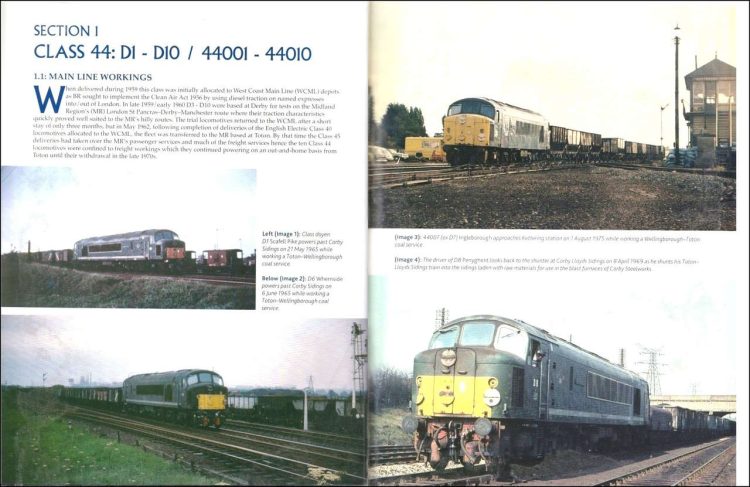
In the captions for the two left-hand photos and the one at the top-right, the author has tried to add a bit of variety to the wording, but the result is unnecessarily repeated as each one begins “44004 Great Gable bears the guise of class doyen D1 Scafell Pike as it …”. Three identical beginnings to captions are less than convincing, added to which is the incorrect use of the word “doyen”.
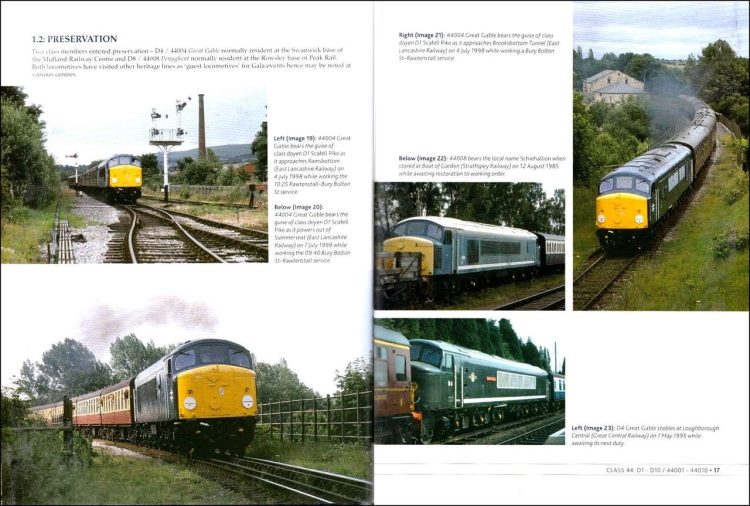
From the end of steam until the introduction of the Class 47s, Classes 45 and 46 were just as dominant on the Northeast to Southwest route as on the Midland Main Line, but the book has only three photos of this route, one of which is the middle-left below taken at Newton Abbot. The four other photos below, as so many others in the book, were taken at Corby or Kettering, emphasising the preponderance of these places as subject locations.
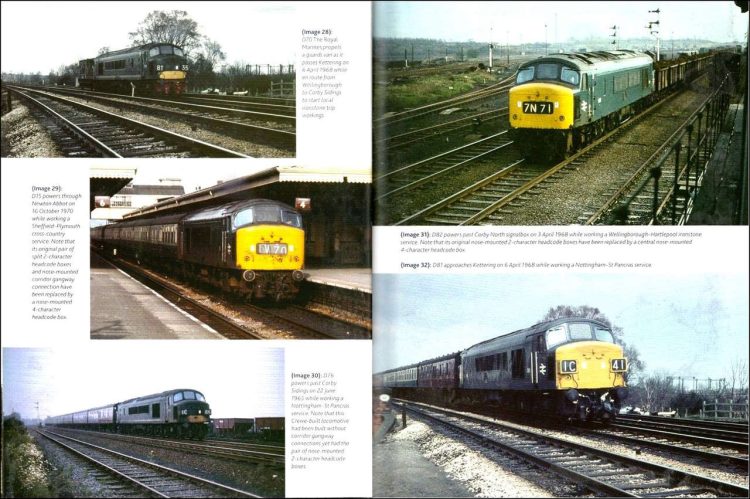
The pages below are yet more photographs taken in the Corby area, which has a higher proportion than would seem reasonable in a book purporting to illustrate their use throughout the country. They also highlight shortcomings in that many of the photos concentrate on the loco instead of also illustrating the train they are hauling.
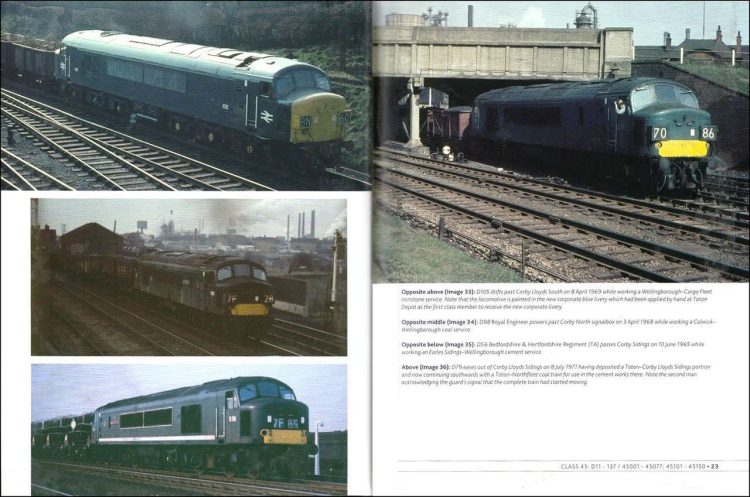
During their time on British Railways Classes 45 and 46 came within the TOPS numbering system, with their original numbers in the “D” series replaced by either a 45 or 46 prefix. However, the captions should just refer to their current number, in the same way that photographs of 60103 Flying Scotsman would never be captioned 60103 (ex-4472). The “45108 (ex-D120)” in the text above the top-left photo illustrates just one of many such examples.
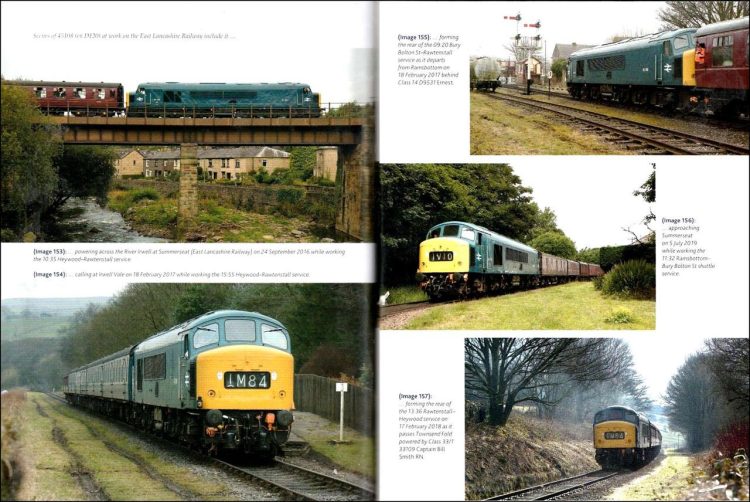
Despite monopolising services on the Northeast-Southwest corridor after the end of steam, the photo at top-left below is just one of three on this route, although it shows a Western Region Bristol to Plymouth service rather than one to or from the Northeast.
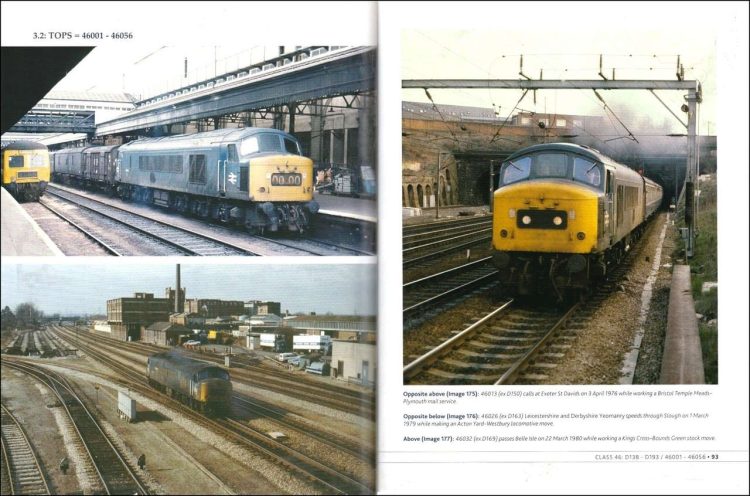
In summary, this is essentially a photograph album showing Classes 44 to 46 in the East Midlands and on preserved railways. Although the book is heavily weighted towards the Midland Main Line, Classes 45 and 46 were for many years, the mainstay on services on the Northeast-Southwest route between Newcastle, Leeds and Sheffield to Birmingham, Bristol and Plymouth. However, that route is almost totally neglected, with just three photographs illustrating services on the route, with none at all between Exeter and Sheffield.
Rather annoyingly, most photographs where the locomotives have been renumbered under TOPS include the original number of the locomotive in captions such as “45 108 (ex-D120)”. As they no longer carry that identity, it is no different to identifying photographs of Flying Scotsman as 60103 (ex-4472).
Although the book has a sub-title of “The Mighty Peaks of the Midland Main Line”, there are only eight photographs taken north of Kettering, with none at Leicester, Nottingham or Leeds, and just two at Derby and Sheffield. It is disappointing that the content has a very poor geographical spread of photographs, and it would have been less misleading if more prominence had been given in the main title to the classes at work in the Northamptonshire area.
I have previously reviewed the author’s book on the Class 66s, which was superb, and included an excellent selection of photographs taken in locations across the whole of the UK and was a fine tribute to the class, Sadly, this is not up to the standards of that volume and can only be recommended for anyone with a particular interest in Classes 44, 45 and 46 at work in Northamptonshire.
The book is available to purchase from Amazon and from Pen & Sword.
RailAdvent would like to thank Pen & Sword for providing it with a copy of the book for review.





Responses
Still a good value book if you can get it at the cheapest quoted price. Good pictures, though strange so many preserved line illustrations.